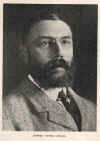|


| |
Arthur Curtiss James
From the October 1926 issue of Great Northern Semaphore
Our Directors
Short Biographical Sketches of Those Who Direct the Policies
and Affairs of the Great Northern Railway Company

No. 1 - Arthur Curtiss James
To the rank and file of railway employes the board of directors
of their railroad is for the most part a remote and all but
mythical body of men who rule over the corporate destinies.
The employes know that "the board" foregathers at stated
intervals to vote heavy expenditures and declare dividends or,
as all too frequently happens with railroads these days, pass
them. (Fortunately, the Great Northern, beginning with the
year 1881 has been able to declare a dividend each year,
including the year just completed.)
But few employes of a railroad know anything of the personality,
or the primary pursuits of the members of the board of directors,
save of the few who are also executives of the company. Yet
these men, by the very fact that they are called on to direct
and control the major affairs of a vast property, are marked
as men who have achieved more than ordinary success in the
field of their major endeavor.
This lack of information is not as should be; and the SEMAPHORE,
knowing that its readers will be keenly interested, purposes
to publish short biographical sketches of those Great Northern
directors who are also actively engaged in the conduct of other
important lines of business.
In contemplating any series of the kind, the director who first
comes to mind is Arthur Curtiss James, of New York City - not
for the reason that he possibly is one of the largest individual
holders of railway stocks living today, or that he is identified
by such ownership with several transcontinental railroads; but
for the reason that he is a man who has achieved a very marked
success in an unusually extensive field of business, industry
and finance, and because of the sentiment inhering in the fact
that as a director of the Great Northern, he occupies a place
held by his father before, for D. Willis James, as close friend
and advisor, was intimately associated with James J. Hill in the
early years of the development of the Great Northern and its
related interests, serving as a director of the St. Paul,
Minneapolis & Manitoba from 1883 to 1888, inclusive, and
maintaining from the first an ever-increasing interest,
both personally and financially, in the success of
the property.
The story of the elder James' connection with the Great Northern
and its predecessors and the interest to which the son, Arthur
Curtiss James, succeeded, is an engaging one and very directly
bears on the life work of the son.
After the Hill-Harriman titanic struggle for control of the
Northern Pacific from which Mr. Hill issued victorious, the
Union Pacific turned its attention to the Southern Pacific
system and later secured control of it. Subsequently it was
forced by decree of court to relinquish that control. Meanwhile,
suspecting a possible design of the Harriman interests to gain
control of the two northern lines, the Northern Pacific and
Great Northern, and as a means of preventing any attempt of
the kind, "fifteen men of advanced years," owners of large
blocks of the two northern companies' securities conceived
the idea of pooling their holdings, and for that purpose
organized the Northern Securities Company, of which D. Willis
James became vice-president and director, and James J. Hill
president.
Mr. James had held a large amount of the securities
of the old Northern Pacific company, and with its reorganization
found himself one of its heavy stockholders. This stock,
together with his large holdings in the Great Northern, he
turned in to the Securities Company in payment for his shares in
that company. When the U.S. Supreme Court, by a five to four
vote, held the Securities Company a violation of the Sherman
anti-trust law, the holdings of the company were distributed
pro rata among its stockholders without reference to the
particular securities they had originally turned in as
payment for stock. As a result, the elder James emerged
from the experience one of the larges holders of both Great
Northern and Northern Pacific stocks.
Mr. James' father was associated, also with interest grouped
about the First National Bank of New York and J. P. Morgan &
Company and was, as senior partner of Phelps Dodge and Company,
developers of vast copper and railroad properties, on of the
outstanding forces in the development of Arizona, especially
in the construction of the El Paso & Southwestern, of which
he was the principal stockholder.
When the Southern Pacific acquired the El Paso & Southwestern,
Thomas M. Schumacher, who had been president of the latter
railroad, became a vice-president of the Southern Pacific
and retired from the Great Northern board, where he had
previously represented Arthur Curtiss James, and Mr. James,
Himself, became a member of the board.
An incident that has rendered Mr. James almost unique among
his associates was his action when the Clayton Act became
effective. Aimed at interlocking directorates, the act forbids
dealings in securities or supplies, or in the making of any
contracts for construction, involving more than $50,000
in any one year, without competitive bids between a railroad
and any concern having as a director, president, manager,
or selling or purchasing agent any person similarly identified
with the railroad, or in which the railroad has any substantial
interest. As the prohibited transactions include the sale of
railroad securities to banks as well as dealing in material
and supplies, many bankers and industrial leaders retired
from railroad boards. Mr. James, on the contrary, elected
to continue as a railroad director, and resigned from those
directorates which were within the inhibition. Needless to
say, this action has earned for him a most enviable
distinction and has made him a notable figure in railroad circles.
Arthur Curtiss James was born in New York City, June 1, 1867.
His collegiate education was secured at Amherst College, of
which his father was a trustee. He was graduated in 1889 with
the degrees of B.A. and M.A. Since entering the business field,
his interests have widened until today his activities are
extremely varied and he is a member of the directorate of
numerous institutions other than those of which he is an
executive and directly concerned in the management. He is
known among financiers as one who has managed the multitudinous
interests of his great estate with rare judgment and notable
ability.
Mr. James is President of the Curtiss Southwestern Corporation,
vice-president of the Phelps dodge Corporation and its
subsidiaries, and is a member of the boards of directors of the
Great Northern and Chicago, Burlington & Quincy railways;
and vice-president and director of the El Paso & Southwestern
Railway Company and its subsidiaries. He is also a director
of the First Securities Company, New York City, trustee of
Amherst College, his alma mater, and of Hampton Normal and
Industrial Institute.
Despite the close attention necessary for the successful
management of his business affairs, Mr. James finds time
to devote to civic and charitable activities, and to several
of New York's famous institutions of research and learning,
notably the Metropolitan Museum of Art, New York Public
Library, the Children's Aid Society, and of Union Theological
Seminary, in each of which he is either a trustee or director.
He is vice-president of the New York Chamber of Commerce and
a member of the American Institute of Mining Engineers,
American Geographical Society, New York Zoological Society,
and New York Botanical Gardens.
Mr. James, in common with a great number of New York's
successful men, is devoted to the sport of yachting. He is
a member of the Atlantic, New York, and Seawanhelm-Corinthian
yacht clubs, serving as commodore of the New York Yacht Club
during 1909 and 1910. Among his other recreations are
horseback riding and tennis.
Mr. James is an only son, and has retained his father's
holdings of Great Northern and Northern Pacific stocks. Other
large holdings have been split up through the death of
James J. Hill and others of the famous "fifteen" who had more
than one heir. The result is that Mr. James is said to be
the largest individual stockholder of Great Northern,
Northern Pacific and Southern Pacific. He recently acquired,
also, a very large holding of Western
Pacific stock, and it
is to be expected that his interest in that property will
result in strengthening its financial position among the
western railroads. While Mr. James is a director of
Great Northern, and vice-president and director of the
El Paso & Southwestern, his interests in Northern Pacific,
Southern Pacific and now the Western Pacific, are represented
by other directors.
THE END
  |